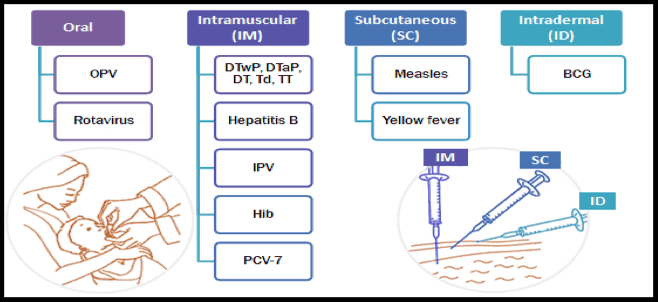Vaccines help prevent diseases and are one of the most important achievements of mankind. Research shows that vaccines help prevent a million deaths per year worldwide, increase average life span, and help eradicate smallpox, which is an infectious disease. The United Nations created several sustainable development goals to ensure a sustainable future for all. One of these goals focuses on good health and well being at all ages. According to the UN, this goal highlights increasing life expectancy, decrease child and maternal mortality, and working towards achieving the target of “less than 70 maternal deaths per 100,000 live births by 2030” and vaccinations play a vital role in decreasing communicable diseases.

Figure 3: Explanation about the Primary and Secondary Antibody ResponsesAdapted from myDr.com.au (Public Domain)
The B-lymphocytes in the body detect these antigens on bacteria and start multiplying. These cloned B cells either become plasma cells or memory cells. The plasma cells secrete antibodies, which are trained to immobilize the bacteria or virus the person is vaccinated against. 9So, during the primary antibody response, the antibody concentration rises gradually and peaks about 2 weeks after vaccination. During the secondary response, one is exposed to an infective organism. Then the memory B cells that have lain dormant in the body instantly recognize the organism. The memory B cells multiply rapidly and then develop into plasma cells. The plasma cells produce a large number of antibodies, which are able to quickly bind and inactivate the infecting organism. So, during the secondary antibody response, the antibody concentration rises quickly, and the response is more intense. The antibody concentration remains higher for a longer period of time.
Seven childhood diseases that could be prevented through immunizations are Diphtheria, Tetanus (lockjaw), Pertussis (whooping cough), Hib (Haemophilus influenzae), Hepatitis B, Polio, and Pneumococcal disease. Currently, children’s vaccinations are administered through the following methods: orally, nasal, intramuscular (IM), subcutaneous (SQ), and intradermally (ID). The oral vaccinations, for example, Oral Poliovirus Vaccine (OPV) and Rotavirus are administered through drops and a live attenuated virus is used to administer flu vaccine nasally. When administering the IM vaccinations such as DTaP (Diphtheria, Tetanus, and Pertussis), one needs to pay attention to the needle length and ensure that the needle is inserted at a 90-degree angle and quickly. However, while administering the SQ such as Measles vaccine, tissue needs to be pinched and the needle should be inserted at a 45-degree angle. Lastly, the intradermal (ID) injections such as the BCG are administered in the topmost layer of the skin. There are several other protocols one needs to follow during administering the vaccinations. It is also crucial the personnel are sufficiently trained to minimize errors and to ensure that the personnel is aware of the needle length, the angle at which it needs to be inserted, and the suggested injection sites are followed. Hence the current research is leaning towards creating needle-free delivery systems.

Figure: 4 Children’s Vaccination Administration SystemsImage source WHO (public domain), https://vaccine-safety-training.org/route-of-administration.html
The needle-free systems do not pose a safety risk to patients, providers, and the community. Out of the 12 billion injections administered to humans per year worldwide, 1 million are childhood vaccines. Next, the issue of compliance- too many vaccinations and needle-phobia and 20% of children experience serious distress. One must take it into consideration the discomfort- reduced pain and soreness at the injection site. Most economical reason would be the increased ease and less training of vaccinators, and decreased costs. The current material cost per vaccination is $0.06 but the societal cost is $26.75 per injection. Another important factor is the speed of delivery. Lastly, Cold Chain is not needed and delivery to remote areas is possible allowing vaccinating 10 million more children. The needle-free systems could easily avoid the problems involved in the cold chain, which provides challenges to the proper and timely delivery of vaccinations to remote areas around the world. It might even reduce the cost involved in the delivery of vaccinations.
To summarize, immunity plays a vital role in keeping us safe from being sick. Major types of immunity include:
- Active immunity is acquired either through exposure to the disease where the immune system produces antibodies to combat the pathogen or through vaccinations. 10This type of immunity is sometimes life-long.
- Passive immunity is acquired through the antibodies that are generated in another host, for example from a mother to an unborn baby or to a newborn baby through breast milk.
- Herd immunity applies to situations where enough people in the community are exposed to the pathogen and this, in turn, slows down the spread of the pathogen.